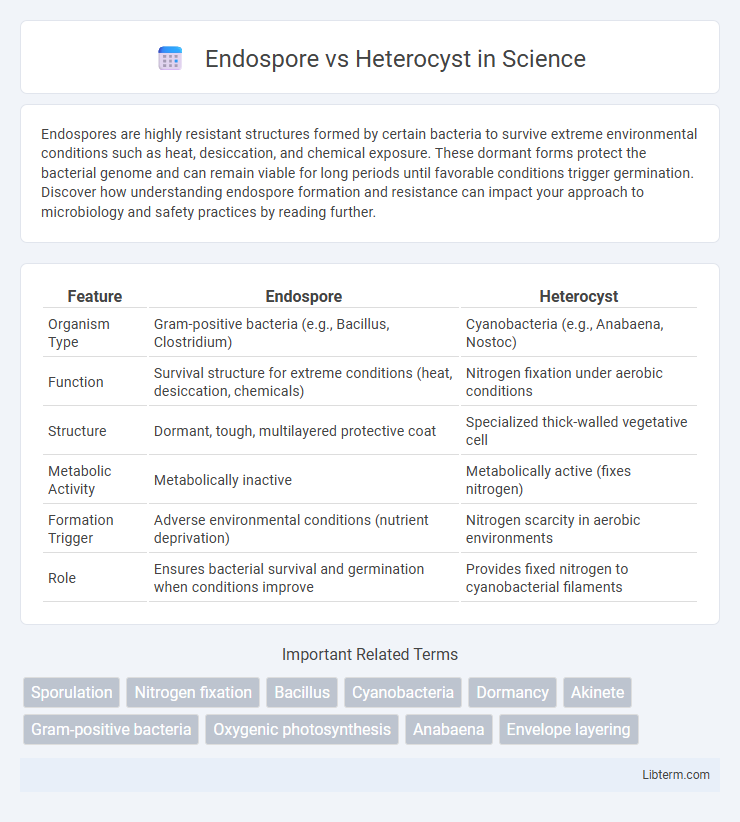Endospores are highly resistant structures formed by certain bacteria to survive extreme environmental conditions such as heat, desiccation, and chemical exposure. These dormant forms protect the bacterial genome and can remain viable for long periods until favorable conditions trigger germination. Discover how understanding endospore formation and resistance can impact your approach to microbiology and safety practices by reading further.
Table of Comparison
| Feature | Endospore | Heterocyst |
|---|---|---|
| Organism Type | Gram-positive bacteria (e.g., Bacillus, Clostridium) | Cyanobacteria (e.g., Anabaena, Nostoc) |
| Function | Survival structure for extreme conditions (heat, desiccation, chemicals) | Nitrogen fixation under aerobic conditions |
| Structure | Dormant, tough, multilayered protective coat | Specialized thick-walled vegetative cell |
| Metabolic Activity | Metabolically inactive | Metabolically active (fixes nitrogen) |
| Formation Trigger | Adverse environmental conditions (nutrient deprivation) | Nitrogen scarcity in aerobic environments |
| Role | Ensures bacterial survival and germination when conditions improve | Provides fixed nitrogen to cyanobacterial filaments |
Introduction to Endospores and Heterocysts
Endospores are highly resistant, dormant structures formed by certain bacteria like Bacillus and Clostridium to survive extreme environmental stress, including heat, desiccation, and chemicals. Heterocysts are specialized nitrogen-fixing cells found in filamentous cyanobacteria such as Anabaena, enabling nitrogen fixation under aerobic conditions by creating a micro-anaerobic environment. Both adaptations reflect distinct survival mechanisms, with endospores ensuring bacterial persistence and heterocysts facilitating nitrogen acquisition in oxygen-rich habitats.
Structural Differences Between Endospores and Heterocysts
Endospores are highly resistant, dormant structures formed within certain bacteria, featuring multiple protective layers including a thick spore coat, cortex, and core, which safeguard the genetic material under extreme environmental stress. Heterocysts are specialized, enlarged cells found in some filamentous cyanobacteria, characterized by a thickened cell wall and absence of photosystem II to create an anaerobic environment necessary for nitrogen fixation. The key structural difference lies in endospores serving as survival capsules with multiple protective layers, while heterocysts function as metabolically active cells adapted for nitrogen fixation with distinct morphological modifications.
Formation Processes: Sporulation vs. Heterocyst Differentiation
Endospore formation, or sporulation, is a complex, multi-stage process triggered by nutrient deprivation in bacteria such as Bacillus and Clostridium, involving asymmetric cell division, engulfment, and synthesis of protective layers like the cortex and spore coat. Heterocyst differentiation occurs in filamentous cyanobacteria like Anabaena under nitrogen limitation, transforming vegetative cells into nitrogen-fixing heterocysts by extensive remodeling of cell wall structures and inactivation of oxygen-evolving photosystem II. These processes highlight distinct cellular strategies: sporulation ensures survival under harsh conditions through dormant spore formation, whereas heterocyst differentiation supports continued growth through specialized nitrogen fixation.
Biological Functions and Roles
Endospores serve as highly resistant survival structures formed by certain bacteria, enabling them to withstand extreme environmental stresses such as heat, desiccation, and chemical exposure. Heterocysts are specialized nitrogen-fixing cells found in some filamentous cyanobacteria, providing an anaerobic environment essential for the functioning of nitrogenase enzymes. While endospores primarily ensure bacterial survival during unfavorable conditions, heterocysts play a crucial role in nitrogen metabolism and cellular differentiation within cyanobacterial colonies.
Environmental Triggers for Formation
Endospores form in response to extreme environmental stress such as nutrient depletion, desiccation, or high temperature, enabling certain bacteria to survive harsh conditions by entering a dormant state. Heterocysts develop in filamentous cyanobacteria under nitrogen-limiting environments to facilitate nitrogen fixation by creating an anaerobic micro-oxic environment necessary for nitrogenase activity. The primary environmental trigger for endospore formation is starvation, while heterocyst differentiation is induced by combined nitrogen scarcity.
Survival Mechanisms in Harsh Conditions
Endospores are highly resistant structures formed by certain bacteria like Bacillus and Clostridium to survive extreme heat, desiccation, and chemical damage, enabling dormancy during unfavorable conditions. Heterocysts, found in filamentous cyanobacteria such as Anabaena, provide a specialized environment for nitrogen fixation by creating an oxygen-free zone essential for enzymatic survival under nitrogen-limiting and oxidative stress conditions. Both adaptations enhance microbial resilience but utilize distinct physiological strategies to endure environmental challenges.
Ecological Significance and Applications
Endospores provide bacteria with enhanced environmental resilience, enabling survival under extreme conditions such as heat, desiccation, and chemical exposure, which is crucial for soil microbial ecology and bioremediation applications. Heterocysts, specialized nitrogen-fixing cells in cyanobacteria, play a key role in sustaining aquatic and terrestrial ecosystems by converting atmospheric nitrogen into bioavailable forms, supporting plant growth and agricultural productivity. Both structures contribute to ecosystem stability and have promising applications in sustainable agriculture and environmental management.
Genetic Regulation and Control
Endospore formation is controlled by the Spo0A master regulator, which initiates a complex genetic cascade involving sigma factors that direct the expression of genes essential for spore coat synthesis, DNA protection, and dormancy. In contrast, heterocyst differentiation is regulated by the transcriptional activator HetR, which coordinates the expression of nitrogen fixation genes and suppresses photosynthetic oxygen evolution, ensuring a microoxic environment. Both processes rely on precise spatial and temporal genetic control mechanisms to enable survival and metabolic specialization under environmental stress.
Similarities and Distinctive Features
Endospores and heterocysts are both specialized structures produced by certain bacteria to survive under adverse conditions, with endospores primarily serving as highly resistant dormant cells in genera like Bacillus and Clostridium, while heterocysts are differentiated nitrogen-fixing cells found in filamentous cyanobacteria such as Anabaena. Both structures enable survival and adaptation, but endospores provide extreme resistance to heat, desiccation, and chemicals, whereas heterocysts facilitate anaerobic environments necessary for nitrogenase activity. Morphologically, endospores are thick-walled and metabolically inactive, contrasting with heterocysts, which are enlarged, have thickened cell walls, and remain metabolically active to support nitrogen fixation.
Conclusion: Key Takeaways on Endospore vs. Heterocyst
Endospores provide bacteria with extreme resistance to environmental stresses such as heat, desiccation, and chemicals, ensuring survival under adverse conditions. Heterocysts, found in certain cyanobacteria, specialize in nitrogen fixation by creating an anaerobic environment necessary for nitrogenase activity. Understanding these distinct cellular adaptations highlights bacterial strategies for survival and metabolic specialization in diverse ecosystems.
Endospore Infographic

 libterm.com
libterm.com